|
WWI G. Rodenstock Munchen Dienstglas D.F.03 6x24 German Military officers binoculars |
|
My G. Rodenstock D.F. 03 binoculars are standard WWI German military officers binoculars.“ K. B. Dienst .” is the abbreviation of K ö niglich Bayerisch Dienstglas” or Royal Bavarian {military} binoculars, and “ D.F. 03 ” is “Doppel Fernrohrglas 03”, or Double Telescope {model 03}, a military model produced starting around 1908 by many German binocular makers before and during WWI, with Rodenstock producing these in 1917-1918 (credit Hans Seeger). As the war progressed and model 08 non prismatic binoculars were issued to non commissioned officers, these were normally issued to infantry officers. |




|
Japanese External Reverse Porro Prism Binoculars. WEBSITE MUSEUM |
|
OTHER BINOCULARS #15 & OPTICAL SIGHTS/ MOSTLY MILITARY |
|
1942 WWII U.S. Army M69C Artillery telescope and sight for the M1, 57mm anti tank artillery gun |
|
The U.S. M1 57mm anti tank gun was a close copy of the British 6 pounder anti tank gun, and around 16,000 were produced from May in 1941 to war end. They employed my M69C artillery telescope/ sight for ranging and sighting, and these were normally stored in a case, then installed when the artillery was emplaced for use. |
|
1942 WWII Swedish Army Svenska Armén NIFE 6x30 military monocular with graticule / ranging grid and case, Optic property Nr. 1507. |


|
M69 Telescope mount, on M1 57mm cannon |





|
1942 Hensoldt German made Swedish Army military binoculars with graticule, ocular guard, uniform strap, and case. |



|
The Swedish army contracted with the German firm Hensoldt of Wetzlar Germany for my 1942 6x30 Swedish military binoculars which came with ocular guard, a 1943 marked Swedish property marked case, button flap, and have a graticule/ ranging grid. They appear to have Hensoldt serial number 539020 and Swedish optical property Nr.12016. The mismatched case originally had binocular Nr.13646. |
|
In September 1939 Sweden made partial mobilizations of troops (Neutralitetsvakten), and on December 1939 Sweden made further troop mobilization and formed a 100,000 man army for Sweden’s NE border with Finland, The rearmament military budget represented 4.6% of Sweden’s GNP by mid 1942. 1,OOO binoculars were contracted from the US in 1940. Quantities of binoculars were contracted from German and Swedish makers in 1941, marked large crown 1942, and delivered 1941-1944 (Info credit: Robert Forslund & Hans Hogman) |

|
1942 WWII Swedish Army Hensoldt Wetzlar 6x30 military binoculars with graticule/ ranging grid & case. Property Nr.140, serial no. 540440. |



|
My 1942 German made Swedish army 6x30 binoculars serial #540440, with Nr.140 optical property number; has a right ocular graticule/ ranging grid; ocular cover; Swedish crown property mark, and mismatched 3 crown marked 1942 case. It has a replaced right ocular plate replaced with a Zeiss Silvamar plate. According to Robert Forsland, the 1942 dated 6x30 binoculars from all makers including Hensoldt, Zeiss, Busch, Nife, Aga contracted to have interchangeable parts. The ocular cover is soldier marked FK Nilsson Frywman. |




|
1941 WWII Bausch & Lomb U.S. made 6x30 Swedish Army military binoculars with graticule, ocular guard, and number matching case. |

|
The Swedish army contracted with the U.S. firm Bausch & Lomb in Rochester New York in 1941 for my 6x30 Swedish military binoculars serial no. 252580, and Swedish army optical property Nr 5186 which came with an ocular rain guard, and Bausch & Lomb brand Swedish property marked case with matching number Nr.5186 |




|
Carl Zeiss Jena German made 8x30 Deltrintem Swedish Army Military Binoculars pre 1942 |


|
My Carl Zeiss Deltrintem 8x30 binoculars are center focus (unusual), and do not have a graticule ranging grid, and I believe they represent a substitute standard contract purchase by the Swedish military of an available binoculars model in the rush to obtain optics in WWII mobilizations. They are marked with a Swedish crown government property mark, and optical property Nr.1039. Thanks to Robert Forslund for personal help confirming identification. |



|
I would like to highly recommend the book “Swedish Military Binoculars” by Robert Forslund as being the foremost resource on this topic. |
|
C.P Goerz German made 6x Swedish Military Binoculars with Ranging Graticule. optical property Nr 358. |


|
My C.P. Goerz binoculars have a right ocular military ranging granticule or grid, so would have been from an original military contract, and are marked with a large Swedish flat bottom crown (stora riksvapnet) government property mark over H.T., believed to likely be a branch of service abbreviation, since similarly marked “A” for Artilleriet and “I” for Infanteriet are know to appear on Swedish binoculars, bayonets and other military equipment. However, I have been unable to identify H.T What appears to be an original engraved property number was crossed out and Nr. 358 added. My binoculars are believed to be a C.P. Goerz Armee-Trieder model, which Goerz actively marketed as a military contract model around WWI. |







|
The Swedish brand Nife (a subsidiary of French owned Swedish firm SAFT Aktiebolag at the time), produced optical military equipment in the 1930’s/ 1940’s in addition to batteries. My Nife Swedish army 6x30 monocular and case are both Swedish crown military property marked, both dated 1942, and both marked with an apparent matching Nr.1507 military optical contract item number, and they have their original straps, leather ocular cover, and yellow ocular filter. The Swedish army is known to have also purchased 1942 dated monoculars from the German firms of Busch, Hensoldt, and Spindler & Hoyer. |
|
1941 WWII SAFT Nife 5 x 25 Swedish Army Svenska Armén Optical Gunsight for Kulsprutam M/36 8x63 mm Machine Gun, with optic property Nr. 2267. |







|
My 1941 Nife Swedish medium machine gun optical sight is unusual in several aspects. First of all “Nife” was a trade marked brand name of SAFT Aktiebolag since 1916, and both this Swedish subsidiary and it’s French parent firm were primarily battery makers (and still are), and so all their various optical products produced in Sweden were almost an ancillary wartime product line. Optical sights on medium machine guns have never been commonly used elsewhere. The reason that Sweden put an optical sight with very complex compensating adjustments on their model 1936 Kulsprutam 8x63 mm Browning design based water cooled machine gun is because the Swedish military at that time were quite interested in indirect or plunging long range fire. (Medium and heavy machine guns are normally considered direct fire weapons). |
|
1962 Swedish Army/ Svenska Armén German made Carl Zeiss 6 x 30B Military binoculars |
|
1948 Swedish Army Svenska Armén NIFE 6x30 military binoculars with graticule/ ranging grid, case, ocular rain cover, and military button flap. Serial number 30323, Optic Property Nr. 20323. |



|
I believe my Nife brand Swedish army 6x30 binoculars were made in a Junger Instruments AB (Nife) plant created in a 1939 cooperative agreement made between the German optical firm Srb & Stys and SAFT Aktiebolag, and the made military optics for the Swedish military. They have serial number 30323, and were made in 1948 They have the post 1944 three crown (lilla riksvapnet) Swedish military property mark, and the optical property number 20323 . (Info credit: Robert Forslund’s definitive 2009 book Swedish Military Binoculars ) |




|
My 1962 Carl Zeiss 6x30 B rubber armored binoculars were made in Germany for a Swedish Army contract. (Zeiss also supplied the same binoculars for a Danish military contract, shown on the page OTHER BINOCULARS #7 ). |



|
1942 WWII Aga Baltic 6x30 Swedish Army military binoculars with graticule, ocular guard, & case |
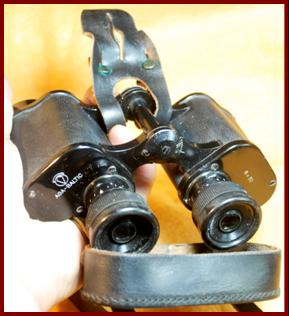




|
AGA-Baltic was a photographic division of Swedish lighting and consumer electrical products company AGA, which produced 2,500 6x30 military binoculars during WWII, including my example dated 1942. Per Robert Forslund, Aga production was in cooperation with Nife, and he cites a 1943 Aga letter to the Arm é f övaltningems Tygdearment about productions delays due to worlers being drafted, and moving production to a delayed underground bombproof factory. These carry the three crown post June 1942 Swedish military three crown ( (lilla riksvapnet) property mark, and optic property Nr.#18351. Info credit Flagorio, Forslund). |

|
WWI era Warner & Swasey 10x U.S. Navy Contract Binoculars |





|
SERIAL NO 104 ? |

|
WWI era German made (probably Busch ?) 7x US Navy Contract Binoculars |
|
Though not brand marked, I believe my PRISMA BINOCLE (prism binoculars) 7x VERGROSSERUNG (7x enlargement) binoculars by their markings and configuration to have been made by the German manufacturer Emil Busch for a U.S. Navy contract, based on a fairly standard model of Busch. (Also U.S. military purchase documentation of my 1916 Busch US Army signal corps binoculars in OTHER BINOCULARS #7 ). The “Eagle”logo on the case buckle is Eagle Lock of Terryville Ct that made the latch. |


|
|
|
|
|
|
|
hvc |
|
|


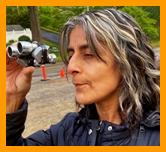
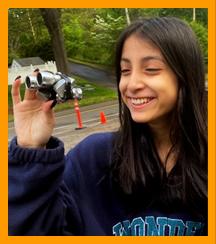


|
NON MINIATURE BINOCULARS AND OPTICS: MOSTLY MILITARY |

|
G.Rodenstock is Optisches Institut G. Rodenstock, founded in 1877 |
|
WWI E. Leitz Wetzlar Dienstglas UF D.F.03 6x24 German Military officers binoculars |
|
My E. Leitz Wetzlar D.F. 03 binoculars are standard WWI German military officer’s binoculars. and “ D.F. 03 ” is “Doppel Fernrohrglas 03”, or Double Telescope {model 03}, a military model produced starting around 1908 by many German binocular makers before and during WWI. UF is Unteroffizier (junior non commissioned officer). This appears to be a low serial number of 731 . I believe the 13. may indicate 1913 production (speculative). |



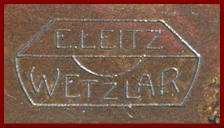
|
1918 British Army A. Kershaw & Son Ltd. No. 3 Mk. II 6 x 30 WWI Military binoculars |
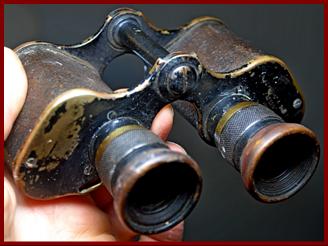



|
My 1918 A. Kershaw & Son Ltd. were made to the No.3 Mk. II pattern from Feb 4 1918, to an outstanding British army order of 25,000 June 1916 binoculars order, using barr & Stroud prisms and Taylor Hobson and Thomas Cooke lenses assembled at the Kershaw factory at 200 Haverhills Lane, Leeds, England. |
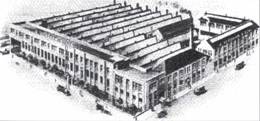
|
Kershaw factory at 200 Haverhills Lane in Leeds |
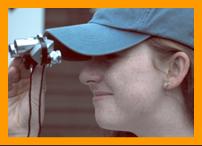
|
UNDER ARMOR MARKING |
|
1942 Swedish Army Svenska Armén NIFE 6x30 military binoculars with graticule/ ranging grid, ocular rain cover, and military button flap. Serial number 13945, Optic Property Nr. 485Hv |


|
I believe my Nife brand Swedish army 6x30 binoculars were made in a Junger Instruments AB (Nife) plant created in a 1939 cooperative agreement made between the German optical firm Srb & Stys and SAFT Aktiebolag, and they made military optics for the Swedish military. My example has serial number 13945, and were made in 1942 .They have the pre 1944 Swedish large single crown military property mark (stora riksvapnet) in th 1920’s, and the optical property number 20323. (Info credit: Robert Forslund’s definitive 2009 reference book Swedish Military Binoculars ) |
|
In addition to the ocular rain guard, these have a military button flap. |
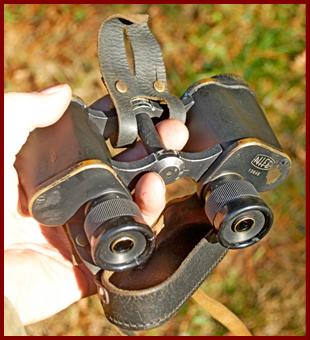
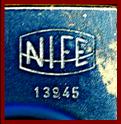

|
In addition to the ocular rain guard, these have a military button flap. |
|
In addition to the ocular rain guard, these have a military button flap. |
|
WWI Oigee Dienstglas UF D.F.03 6x24 German Military officers binoculars |

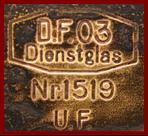
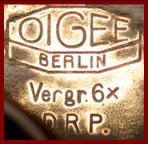
|
My Oigee (Optische Anstalt Oigee) D.F. 03 binoculars serial # 1519 are standard WWI German military officer’s binoculars. and “ D.F. 03 Dienstglas ” is “Doppel Fernrohrglas 03 Dienstglas”, or Double Telescope {model 03} service glass, a military model produced starting around 1908 by many German binocular makers before and during WWI. “ UF ” is Unteroffizier (junior non commissioned officer). The “ K ” mark on the bridge is the acceptance mark of Gewehr Prufungskommission Spandau. |

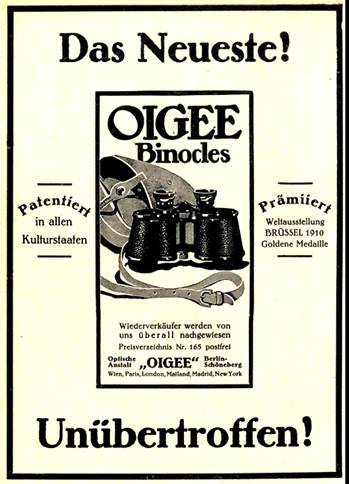
|
1912 Oigee binoculars ad |


![Text Box: CLICK ON PAGE LINE. CLIQUEZ SUR LA LIGNE DE PAGE. KLICKEN SIE AUF SEITENZEILE. HAGA CLIC EN LÍNEA DE PÁGINA..[ページ行]をクリックします。НАЖМИТЕ НА СТРОКУ СТРАНИЦЫ. ALSO SEE INDEX.](image3473.gif)